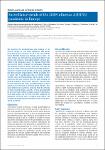Surveillance trends of the 2009 influenza A(H1N1) pandemic in Europe
Amato-Gauci, Andrew
Zucs, Phillip
Snacken, R.
Ciancio, B. C.
Lopez, V.
Broberg, E.
Penttinen, P.
Nicoll, A.
We describe the epidemiology and virology of the official length of the 2009 pandemic (68 weeks from April 2009 to August 2010) in the 27 European Union Member States plus Norway and Iceland. The main trends are derived from published literature as well as the analysis and interpretation of data provided to the European Centre for Disease Prevention and Control (ECDC) through the European Influenza Surveillance Network (EISN) and data collected by the ECDC itself. The 2009 influenza A(H1N1) pandemic started in Europe around week 16 of 2009 (although the World Health Organization (WHO) declared only in week 18). It progressed into an initial spring/summer wave of transmission that occurred in most countries, but was striking only in a few, notably the United Kingdom. During the summer, transmission briefly subsided but then escalated again in early autumn, just after the re-opening of the schools. This wave affected all countries, and was brief but intense in most, lasting about 14 weeks. It was accompanied by a similar but slightly delayed wave of hospitalisations and deaths. By the time the WHO declared the pandemic officially over in August 2010 (week 32), Europe had experienced transmission at low level for about 34 weeks.
Dateien zu dieser Publikation
Keine Lizenzangabe
Verwandte Publikationen
Anzeige der Publikationen mit ähnlichem Titel, Autor, Urheber und Thema.
-
2016-02-18ZeitschriftenartikelVaccine effectiveness in preventing laboratory-confirmed influenza in primary care patients in a season of co-circulation of influenza A(H1N1)pdm09, B and drifted A(H3N2), I-MOVE Multicentre Case–Control Study, Europe 2014/15 Valenciano, Marta; Kissling, Esther; Reuss, Annicka; Rizzo, C.; Gherasim, A.; Horváth, Judit K.; Domegan, L.; Pitigoi, Daniela; Machado, Ausenda; Bella, A.; Paradowska-Stankiewicz, I.; Larrauri, A.; Ferenczi, A.; O´Donell, Joan; Lazar, M.; Pechirra, P.; Korczyńska, M. R.; Pozo, Francisco; Moren, A.Influenza A(H3N2), A(H1N1)pdm09 and B viruses co-circulated in Europe in 2014/15. We undertook a multicentre case–control study in eight European countries to measure 2014/15 influenza vaccine effectiveness (VE) against ...
-
2016-10-13ZeitschriftenartikelImproving influenza virological surveillance in Europe: strain-based reporting of antigenic and genetic characterisation data, 11 European countries, influenza season 2013/14 Broberg, E.; Hungnes, Olav; Schweiger, Brunhilde; Prosenc, Katarina; Daniels, R.; Guiomar, R.; Ikonen, N.; Kossyvakis, A.; Pozo, Francisco; Puzelli, S.; Thomas, I.; Waters, A.; Wiman, Å.; Meijer, AdamInfluenza antigenic and genetic characterisation data are crucial for influenza vaccine composition decision making. Previously, aggregate data were reported to the European Centre for Disease Prevention and Control by ...
-
2013-02-14ZeitschriftenartikelEarly estimates of seasonal influenza vaccine effectiveness in Europe: results from the i-move multicentre case–control study, 2012/13 Valenciano, M.; Kissling, E.We conducted a test-negative case–control study based in five European sentinel surveillance networks. The early 2012/13 adjusted influenza vaccine effectiveness was 78.2% (95% CI: 18.0 to 94.2) against influenza B, 62.1% ...

